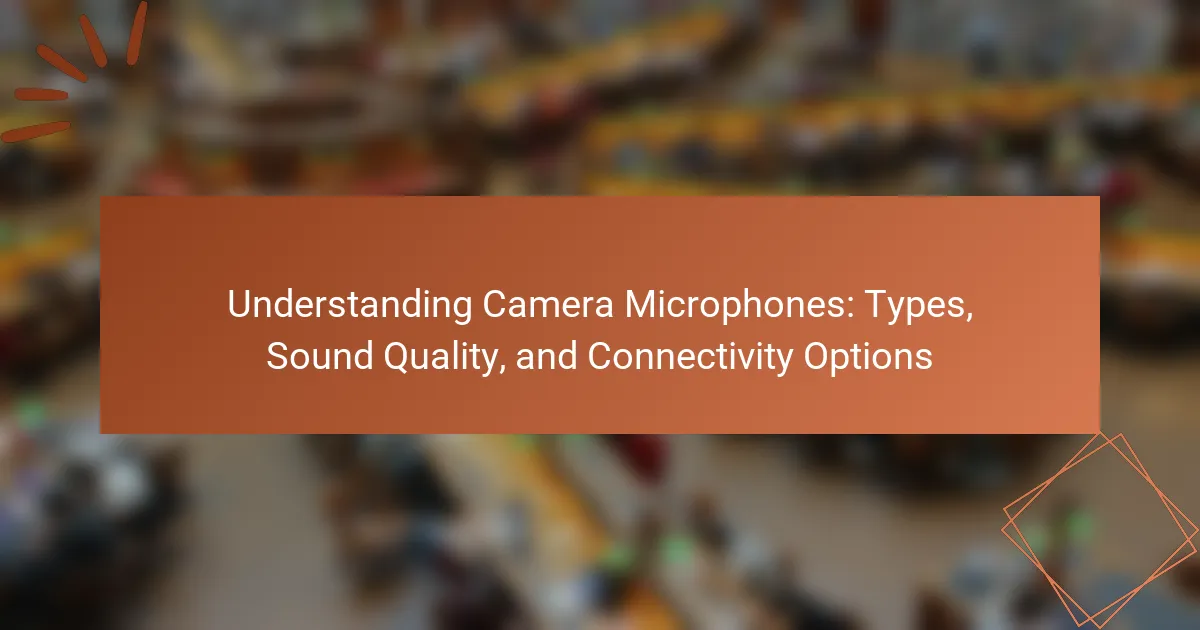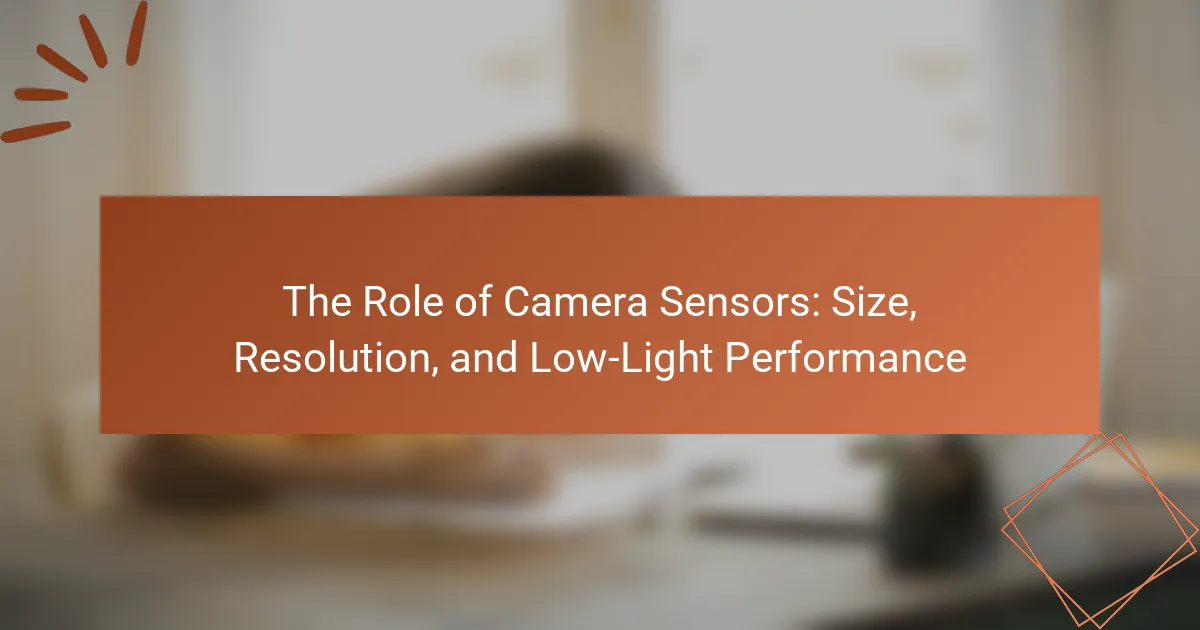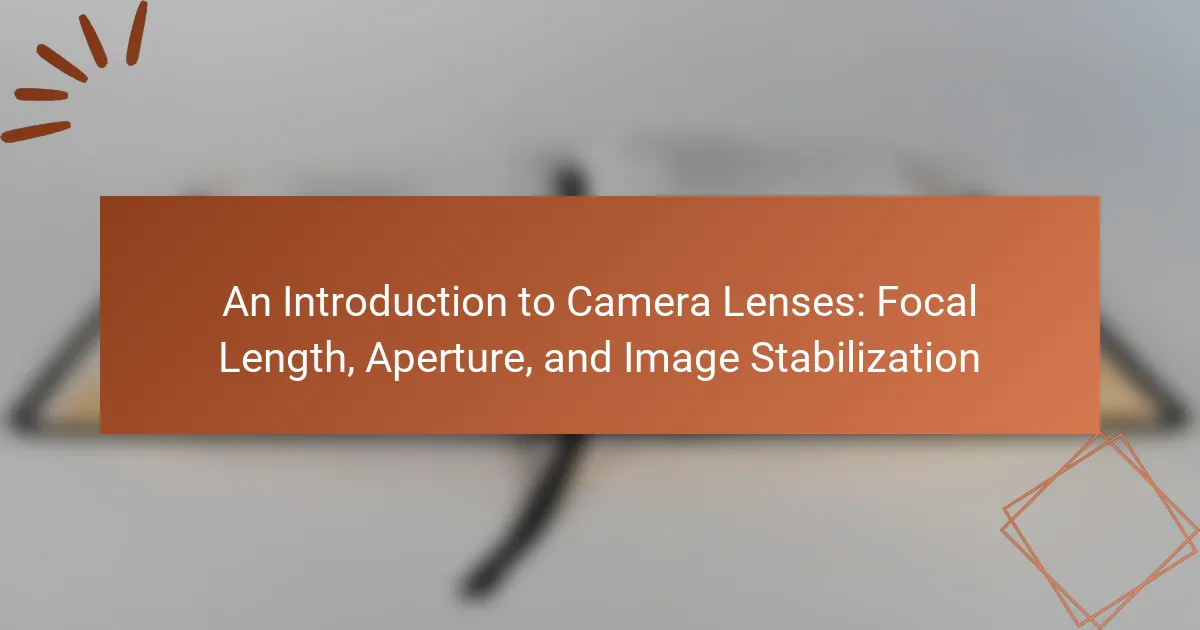DSLR cameras, or digital single-lens reflex cameras, utilize a mirror system to channel light from the lens to an optical viewfinder, providing photographers with a clear preview of their shots. Known for their superior image quality and versatility, DSLR cameras feature larger sensors that enhance performance in low-light conditions and support interchangeable lenses for various photography styles. This article outlines the different types of lenses available for DSLR cameras, including prime, zoom, wide-angle, telephoto, macro, and fisheye lenses, each serving specific photographic needs. Additionally, the article highlights the best uses of DSLR cameras in professional photography and videography, emphasizing their capabilities in capturing high-resolution images and high-definition video.

What are DSLR Cameras?
DSLR cameras are digital single-lens reflex cameras. They use a mirror system to direct light from the lens to an optical viewfinder. This allows photographers to see exactly what will be captured. DSLR cameras are known for their high image quality and versatility. They typically have larger sensors than compact cameras. This results in better performance in low light situations. Many DSLR cameras offer interchangeable lenses for different shooting styles. They are popular among both amateur and professional photographers.
How do DSLR Cameras differ from other camera types?
DSLR cameras differ from other camera types primarily due to their use of a mirror mechanism and optical viewfinder. This design allows photographers to see exactly what the lens sees, providing real-time feedback. In contrast, mirrorless cameras use electronic viewfinders or LCD screens, which can introduce a slight lag. DSLRs typically offer better battery life compared to mirrorless cameras, as they do not rely on electronic displays. Additionally, DSLRs often have a wider selection of lenses and accessories available, enhancing versatility. The larger sensor size in many DSLRs can result in better image quality, particularly in low light conditions. These characteristics establish DSLRs as a preferred choice for professional photographers and serious enthusiasts.
What is the significance of a digital single-lens reflex mechanism?
The digital single-lens reflex (DSLR) mechanism is significant because it allows photographers to see exactly what the lens sees. This is achieved through a mirror system that reflects light from the lens into an optical viewfinder. When the shutter button is pressed, the mirror flips up, allowing light to hit the image sensor. This mechanism provides a real-time optical view, enabling accurate framing and focus. Additionally, DSLRs typically offer faster autofocus and better performance in low-light conditions compared to other camera types. The combination of these features makes DSLRs a preferred choice for both amateur and professional photographers.
How does image quality compare across different camera types?
Image quality varies significantly across different camera types. DSLRs typically offer superior image quality due to larger sensors and interchangeable lenses. Mirrorless cameras also provide high image quality, often matching DSLRs, while being more compact. Compact cameras generally have smaller sensors, resulting in lower image quality compared to DSLRs and mirrorless models. Smartphone cameras have improved greatly but still lag behind dedicated cameras in low-light conditions and dynamic range. The sensor size, lens quality, and processing capabilities are key factors influencing image quality across these types.
What are the key features of DSLR Cameras?
DSLR cameras are characterized by several key features. They have a digital image sensor that captures high-quality images. A mirror mechanism allows for accurate framing through an optical viewfinder. Interchangeable lenses provide versatility for various photography styles. Manual controls enable photographers to adjust settings like aperture and shutter speed. They typically offer fast autofocus systems for quick subject tracking. Many DSLRs have larger batteries for extended shooting sessions. A robust build ensures durability in various environments. Finally, they support various image formats, including RAW, for greater post-processing flexibility.
How does sensor size impact image quality?
Sensor size significantly impacts image quality in photography. Larger sensors capture more light, resulting in better detail and dynamic range. This leads to improved performance in low-light conditions. Smaller sensors often produce more noise at high ISO settings. Additionally, larger sensors provide a shallower depth of field, enhancing background blur. The difference in size affects the overall image sharpness and color accuracy. Research indicates that full-frame sensors outperform crop sensors in various image quality metrics. Thus, sensor size is a critical factor in determining the quality of photographs taken with DSLR cameras.
What role does autofocus play in photography?
Autofocus is a critical feature in photography that enables cameras to automatically adjust the lens to achieve sharp focus on a subject. This function enhances the speed and accuracy of focusing, allowing photographers to capture images quickly without manual adjustments. In fast-paced environments, such as sports or wildlife photography, autofocus ensures that moving subjects remain in focus. Most modern DSLR cameras utilize phase detection or contrast detection for autofocus, which increases focusing efficiency. Studies show that cameras with advanced autofocus systems can significantly improve the likelihood of capturing sharp images, especially in challenging lighting conditions.
How do ISO settings affect exposure and noise?
ISO settings directly influence exposure and noise in photography. A higher ISO setting increases the camera’s sensitivity to light, allowing for better exposure in low-light conditions. However, this increased sensitivity also introduces more noise, which appears as graininess in images. Conversely, a lower ISO setting results in less sensitivity, yielding cleaner images with less noise but requiring more light for proper exposure. Research indicates that noise levels typically rise significantly above ISO 1600 in most DSLR cameras, impacting image quality. Therefore, balancing ISO settings is crucial for achieving optimal exposure while minimizing noise.
What are the advantages of using DSLR Cameras?
DSLR cameras offer several advantages for photography enthusiasts. They provide superior image quality due to larger sensors. Larger sensors capture more light, resulting in better low-light performance. DSLR cameras also have interchangeable lenses, allowing for versatility in shooting. Photographers can choose lenses based on specific needs, such as macro or wide-angle shots.
Additionally, DSLRs feature faster autofocus systems, which enhance the ability to capture moving subjects. They also provide manual control over settings, giving photographers creative freedom. The optical viewfinder offers a real-time view of the scene, ensuring accurate framing.
Furthermore, DSLRs typically have longer battery life compared to mirrorless cameras. This allows for extended shooting sessions without frequent recharging. According to a 2020 survey by the Camera and Imaging Products Association, DSLRs remain popular among professionals for their reliability and performance.
How do interchangeable lenses enhance versatility?
Interchangeable lenses enhance versatility by allowing photographers to select lenses suited for different shooting scenarios. This adaptability enables the capture of a wide range of subjects, from landscapes to portraits. Different lenses offer unique focal lengths and apertures, influencing depth of field and image composition. For example, a wide-angle lens is ideal for expansive scenes, while a telephoto lens is perfect for distant subjects. The ability to switch lenses provides creative freedom and improves overall image quality. According to a study by Nikon, photographers using interchangeable lenses report greater satisfaction and improved results in various photography styles.
What benefits do manual controls provide for photographers?
Manual controls provide photographers with greater creative control over their images. They allow adjustment of exposure settings like aperture, shutter speed, and ISO. This flexibility enables photographers to achieve desired effects in various lighting conditions. Manual controls also foster a deeper understanding of photography fundamentals. Photographers can experiment with different settings to see immediate results. This hands-on approach enhances skills and confidence. Additionally, manual controls can improve the quality of images by enabling precise adjustments. For instance, controlling depth of field can create stunning portraits. Overall, manual controls empower photographers to express their vision effectively.

What types of lenses are available for DSLR Cameras?
DSLR cameras are compatible with several types of lenses. These include prime lenses, which have a fixed focal length. Zoom lenses offer a range of focal lengths for versatility. Wide-angle lenses capture broader scenes, ideal for landscapes. Telephoto lenses are designed for distant subjects, like wildlife. Macro lenses are specialized for extreme close-ups of small subjects. Fisheye lenses provide a unique, distorted perspective. Each lens type serves specific photographic needs and enhances creative possibilities.
What are the main categories of DSLR camera lenses?
The main categories of DSLR camera lenses are prime lenses, zoom lenses, macro lenses, wide-angle lenses, telephoto lenses, and fisheye lenses. Prime lenses have a fixed focal length, offering superior image quality. Zoom lenses provide variable focal lengths, allowing for versatile framing. Macro lenses are designed for close-up photography, capturing fine details. Wide-angle lenses have a short focal length, ideal for landscapes and architecture. Telephoto lenses have long focal lengths, suitable for wildlife and sports photography. Fisheye lenses create a spherical, distorted image, often used for artistic effects. Each category serves distinct purposes in photography, catering to various creative needs.
What are prime lenses and their advantages?
Prime lenses are fixed focal length lenses that do not zoom. They typically offer superior optical quality compared to zoom lenses. This is due to fewer glass elements and simpler design. Prime lenses often have larger maximum apertures, allowing for better low-light performance. The wider apertures also create a shallower depth of field, enhancing background blur. Additionally, they tend to be lighter and more compact, making them easier to carry. Photographers often prefer prime lenses for portrait, street, and landscape photography due to these advantages.
What are zoom lenses and when should they be used?
Zoom lenses are camera lenses that allow users to change the focal length, enabling a range of magnifications. They provide versatility by allowing photographers to capture both wide-angle and telephoto shots without changing lenses. Zoom lenses are particularly useful in dynamic environments where subjects may be at various distances. They are ideal for events, wildlife photography, and travel, where quick adjustments are often necessary. The convenience of zoom lenses can enhance the shooting experience, as they reduce the need to carry multiple fixed focal length lenses. This adaptability makes them popular among both amateur and professional photographers.
What are specialty lenses, such as macro or fisheye?
Specialty lenses are unique types of camera lenses designed for specific photographic effects. Macro lenses allow for extreme close-up photography, capturing fine details of small subjects. Fisheye lenses provide an ultra-wide-angle view, creating a distorted, spherical effect. These lenses enhance creativity and versatility in photography. Macro lenses typically have a 1:1 magnification ratio, allowing for life-size images. Fisheye lenses can have a field of view of up to 180 degrees. Both types are essential tools for photographers seeking to expand their artistic expression.
How do lens specifications affect photography?
Lens specifications directly influence the quality and style of photography. Key specifications include focal length, aperture, and lens type. Focal length affects the field of view and perspective. For example, a 24mm lens captures wide landscapes, while a 200mm lens is ideal for distant subjects. Aperture controls the amount of light entering the camera. A lower f-number, like f/1.8, allows more light and creates a shallow depth of field. This results in blurred backgrounds, emphasizing the subject. Lens type, such as prime or zoom, affects versatility. Prime lenses offer superior image quality, while zoom lenses provide flexibility in framing. Each specification shapes how images are captured and perceived.
What does focal length mean for composition?
Focal length refers to the distance between the lens and the image sensor when the subject is in focus. It significantly affects composition by determining the field of view and the level of zoom. A shorter focal length captures a wider scene, ideal for landscapes or group shots. Conversely, a longer focal length allows for close-ups, isolating subjects from the background. This manipulation of perspective influences how elements are arranged within the frame. For example, a 24mm lens provides a broader perspective than a 200mm lens, which compresses space. Understanding focal length helps photographers make informed decisions about framing and subject emphasis.
How does aperture influence depth of field?
Aperture directly influences depth of field in photography. A wider aperture (lower f-stop number) results in a shallower depth of field. This creates a blurred background, isolating the subject. Conversely, a narrower aperture (higher f-stop number) increases depth of field. This keeps more of the scene in focus, suitable for landscapes. The effect of aperture on depth of field is a fundamental principle in photography. It allows photographers to control focus creatively. For example, an aperture of f/2.8 yields a shallow depth of field, while f/16 provides a deep focus effect. This relationship is essential for achieving desired artistic outcomes in images.

What are the best uses for DSLR Cameras?
DSLR cameras are best used for professional photography, including portrait, landscape, and wildlife photography. Their large sensors capture high-resolution images with great detail. The interchangeable lenses offer versatility for various shooting scenarios. Fast autofocus systems enable quick and accurate focusing, essential for action shots. DSLR cameras excel in low-light conditions, thanks to their larger sensors. They also provide manual control over settings, allowing photographers to adjust exposure and depth of field. Additionally, they are ideal for videography, offering high-definition video recording capabilities. These features make DSLR cameras a preferred choice among serious photographers and videographers.
What types of photography benefit most from DSLR Cameras?
DSLR cameras benefit most types of photography that require high image quality and versatility. This includes portrait photography, where detail and color accuracy are crucial. Landscape photography also benefits from DSLRs due to their ability to capture wide dynamic ranges and fine details. Wildlife photography is enhanced by fast autofocus systems and the option for telephoto lenses. Sports photography takes advantage of high frame rates and quick shutter speeds available in DSLRs. Additionally, macro photography is supported by the precise control over depth of field that DSLRs provide. These advantages stem from the larger sensors and interchangeable lenses typical of DSLR cameras, allowing for greater creative control and superior image quality.
How are DSLR Cameras used in landscape photography?
DSLR cameras are used in landscape photography to capture detailed and high-quality images of natural scenes. They offer interchangeable lenses, allowing photographers to select the best focal length for their composition. Wide-angle lenses are commonly used to encompass expansive views. DSLR cameras also provide manual controls for exposure settings, enabling photographers to adjust aperture, shutter speed, and ISO for optimal results. The large image sensors in DSLRs enhance dynamic range and low-light performance. Additionally, the use of tripods stabilizes the camera for long exposure shots, reducing blur. Landscape photographers often utilize features like live view and grid overlays to compose their shots effectively. These capabilities make DSLR cameras a preferred choice for capturing stunning landscapes.
What are the advantages of DSLR Cameras for portrait photography?
DSLR cameras offer several advantages for portrait photography. They provide superior image quality due to larger sensors. This results in better detail and color accuracy. DSLR cameras also excel in low-light conditions, allowing for clearer images with less noise. The ability to use interchangeable lenses enhances versatility. Photographers can select lenses that create desired effects, such as shallow depth of field. Fast autofocus systems in DSLRs improve subject tracking. This is crucial for capturing expressions and movements. Additionally, optical viewfinders provide a real-time view of the scene. This helps in composing shots accurately. These features make DSLRs a preferred choice for portrait photographers.
How do DSLR Cameras perform in sports and action photography?
DSLR cameras excel in sports and action photography due to their fast autofocus systems and high continuous shooting speeds. These cameras typically offer burst rates of 5 to 14 frames per second, allowing for capturing rapid movements. Their larger sensors provide better performance in low light, crucial for indoor sports. Additionally, DSLRs have a wide selection of lenses, including telephoto options, which are essential for distant subjects. The optical viewfinder offers real-time viewing without lag, improving composition during fast-paced events. Many DSLRs also feature advanced image stabilization, reducing blur from camera shake. Overall, their combination of speed, versatility, and image quality makes DSLRs a preferred choice for sports and action photography.
What are some tips for maximizing the use of a DSLR Camera?
To maximize the use of a DSLR camera, familiarize yourself with its manual settings. Adjusting aperture, shutter speed, and ISO allows for creative control over exposure. Use a tripod to stabilize your shots, especially in low-light conditions. Experiment with different lenses to achieve varied perspectives. Regularly clean the lens and sensor to maintain image quality. Take advantage of the camera’s autofocus modes for precise focusing. Utilize the histogram feature to ensure proper exposure. Lastly, practice regularly to improve your skills and understand your camera’s capabilities.
How can understanding exposure settings improve results?
Understanding exposure settings can significantly enhance photographic results. Proper exposure settings control the amount of light hitting the camera sensor. This affects image brightness, contrast, and detail. For example, using a faster shutter speed can freeze motion, while a slower speed captures movement blur. Adjusting the aperture influences depth of field, impacting focus on subjects. ISO settings determine sensor sensitivity to light, affecting graininess. Mastering these settings allows photographers to adapt to varying lighting conditions. Studies show that well-exposed images are more visually appealing and engaging. Effective use of exposure settings leads to higher quality photographs.
What are best practices for maintaining a DSLR Camera?
Regularly clean the camera body and lens to prevent dust accumulation. Use a microfiber cloth for gentle cleaning. Check and clean the lens regularly to maintain image quality. Store the camera in a cool, dry place to avoid moisture damage. Use a protective case when transporting the camera. Regularly update the camera firmware for optimal performance. Inspect and replace the battery as needed to ensure reliable operation. Finally, handle the camera with care to prevent physical damage.
DSLR cameras, or digital single-lens reflex cameras, are known for their high image quality, versatility, and use of a mirror mechanism that allows real-time optical viewing. This article explores the key features of DSLR cameras, including their larger sensors, interchangeable lenses, and advanced autofocus systems, which enhance performance in various photography styles such as portrait, landscape, and sports photography. It also covers the different types of lenses available, including prime, zoom, and specialty lenses, and discusses how factors like sensor size and aperture influence image quality and composition. Additionally, tips for maximizing the use of DSLR cameras and best practices for maintenance are provided to help photographers achieve optimal results.



